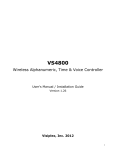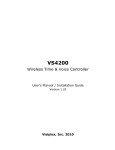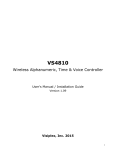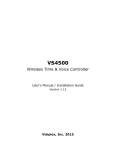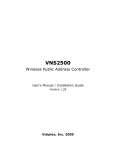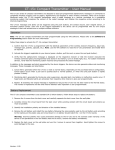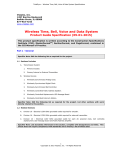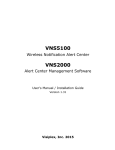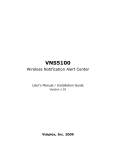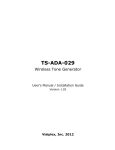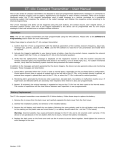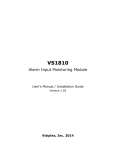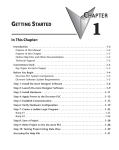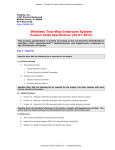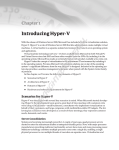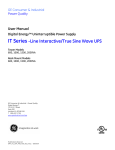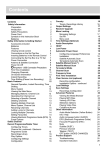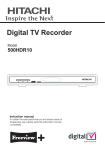Download VS4500 - Visiplex
Transcript
VS4500 Wireless Time & Voice Controller User's Manual / Installation Guide Version 1.03 Visiplex, Inc. 2011 VS4500 Wireless Time & Voice Controller Copyright The product described in this manual includes copyrighted Visiplex computer programs stored in semiconductor memories and computer files. As such, these programs may not be copied or reproduced in any manner without the express written permission of Visiplex, Inc. Disclaimer The information within this document has been carefully checked and is believed to be entirely reliable. However, no responsibility is assumed for inaccuracies. Visiplex, Inc. reserves the right to make changes to any of the products herein to improve reliability, functionality or design. Copyright ©Visiplex, Inc. Vernon Hills, IL 2011 Notice to User Regarding Radio Frequency Interference This equipment has been tested and found to comply with the limits for a Class B digital device, pursuant to Part 15 of the FCC Rules. These limits are designed to provide reasonable protection against harmful interference when the equipment is operated in a commercial environment. This equipment generates, uses and can radiate radio frequency energy and if not installed and used in accordance with the instruction manual, may cause harmful interference to radio communications. Operation of this equipment in residential areas is likely to cause harmful interference in which case the user will be required to correct the interference at their expense. About This Manual This VS4500 User’s Manual / Installation Guide describes the installation and setup procedures of the VS4500 for wireless messaging. It also provides instructions for transmitter antenna installation. It is imperative the manual is followed in the order it is presented to prevent damage to the equipment, as well as insuring proper system functionality. The manual provides instructions for mounting preparation, determining system location and spacing in regard to antennas and other equipment. Information is also provided for verification of reception and transmission quality and troubleshooting of problems that may arise during installation or operation. 2 Table of Contents Product Information 1.1 Introduction 1.2 Standard Features 1.3 Optional Features 1.4 Package Contents 1.5 Key Navigation 1.6 Display Indicators 1.7 Pre-Installation Test for Wireless Clocks Installation 2.1 Site Inspection and System Location 2.2 GPS Receiver Installation (optional) 2.3 Magnetic Mount Antenna (VS638) Installation 2.4 Base Station Outdoor Antenna Kit (VS654) Installation 2.5 VS4500 Encoder and External Transmitter Installation Advanced System Information 3.1 Administration Menu 3.1.1 Device Database Menu 3.1.2 Time Setup Menu 3.1.3 Date Setup Menu 3.1.4 View Messages Menu 3.1.5 Coverage Test Menu 3.1.6 Time Zone Setup Menu 3.1.7 Last Messages Menu 3.1.8 Reset Database Menu 3.1.9 Sunset / Sunrise Menu 3.1.10 Wireless Setup Menu 3.1.11 Operation Modes Menu 3.1.12 System Setup Menu 3.2 Installation Mode Menu 3.3 Page To Menu 3.4 Accessing Wireless Receivers via Telephone 3.4.1 Accessing Standard Devices 3.4.2 Accessing Wireless Voice or Tone Receivers 3.5 Accessing Wireless Voice Receivers via Microphone 3.6 Pre-Programmed Messages 3.6.1 PABX Messages 3.6.2 FreeText 3.6.3 Wireless Devices Software 4.1 VisiDB 4.1.1 Connections 4.1.2 Software Installation 4.1.3 Software Configuration 4.1.4 Setting Date and Time from PC 4.1.5 Tone Schedule Programming 4.1.6 Scheduled Paging 4.1.7 Wireless Device Database Programmer 5 6 6 6 6 6 7 8 8 8 8 9 10 10 11 11 11 11 12 12 12 12 12 14 15 17 17 17 17 18 19 19 19 19 19 21 21 21 21 22 22 30 31 3 4.2 TimeSync 4.2.1 Connections 4.2.2 Software Installation 4.2.3 Software Configuration 4.2.4 Setting the PC Clock from Encoder 4.2.5 Setting the Encoder Clock from PC Clock Appendices 5.1 Appendix A – Installation Diagrams 5.2 Appendix B – Connections, Wiring and Pin Out General Information 6.1 Specifications 6.2 Warranty 31 32 32 32 33 34 35 37 39 40 4 Product Information 1.1 Introduction The VS4500 offers the latest and most innovative way to incorporate PC clock or GPS synchronized time and voice and data throughout your facility, providing you with the benefits of improved productivity and reduced maintenance costs. The VS4500 wireless controller is a sophisticated time, bell and voice management system that can synchronize all facility wireless clocks to one accurate atomic time, run a schedule of bells/alerts, initiate live or prerecorded voice messages and send alphanumeric messages to LED displays. Additional features of the VS4500 include an optional PBX interface and optional hand held microphone. The VS4500 uses the PC clock as a time source for wireless analog clocks, wireless digital clocks and wireless alphanumeric displays. The VS4500 can also be used to synchronize older wired clocks using a special wireless receiver. Using the connected PC clock or GPS receiver, the VS4500 updates its internal clock every few minutes and sends a wireless data signal every minute to provide time synchronization information to all system clocks. The VS4500 is a powerful microprocessor-based desktop paging system capable of addressing up to 1000 receivers. It consists of a fully featured encoder with a 2 line by 16-character LCD display and a numeric keypad mounted in a wall or desk mountable housing. The VS4500 is compatible with the Visiplex series of digital transmitters ranging from 6 to 300 watts. An internal 6 watt transmitter can be installed at the factory and larger transmitters are available as separate items. 5 1.2 Standard Features Generate alerts to alphanumeric and numeric devices, voice or tone devices, and wireless clocks User configurable 1000 devices database RS232 serial port for serial communication Built-in high-precision Real-Time clock Capable of synchronizing its internal clock from a PC clock or GPS (requires external GPS receiver) Synchronize both analog and digital wireless clocks User configurable Master Clock synchronization time External transmitter port Backlit LCD display Numeric keypad Built-in memory backup Desk or wall mountable 1.3 Optional Features Telephone line interface (RJ-11) for remote status change of system mode and live voice alerts Hand held microphone for live voice alerts Additional one serial port for extended serial communication Built-in scheduled tone activation for wireless receivers High power external digital transmitters (25 to 300 watt) Automated activation of wireless voice devices from external audio source 900MHz or UHF Wireless receiver for monitoring 900MHz or UHF wireless push buttons and transmitters 1.4 Package Contents The following items are included with the VS4500: VS4500 Wireless Time & Voice Controller Power adaptor Manual RS232 communication cables 1.5 Key Navigation The following keys also function in system menus as detailed below: # Select / Acknowledge / Enter * Return to previous menu / Escape 1 On / Next 0 Off / Previous 1.6 Display Indicators Time source reception status (displayed between the hour and minutes segments) and daylight saving status (displayed to the left of the hour segment) indicators are displayed on the main menu: . No connection with time source ; No GPS or PC clock data reception detected : GPS or PC clock data reception detected, date and time updated * Daylight saving time is active 6 1.7 Pre-Installation Test for Wireless Clocks It is recommended to test the VS4500 and the entire system prior to installation in order to verify proper operation and get familiar with the unit operation. Follow these steps to perform a pre-installation test: 1. If your system is equipped with an internal transmitter, connect the BNC antenna cable to the RF-OUT terminal at the back of the VS4500. If your system uses an external transmitter, connect the transmitter data cable between the VS101-XX transmitter and the DATA I/O port at the back of the VS4500. Connect the antenna to the external transmitter’s RF-OUT terminal. 2. Connect the provided power supply to the POWER jack at the back of the VS4500 and turn the power switch to ON position. The main menu should appear with the PAGE TO: displayed on the top line. If you are using an external transmitter make sure it is powered on. 3. Press the B key for the Administration Menu and enter the default password (4500). The menu top line should display SELECT OPTION: 4. Press 2 followed by the # key for the internal clock Time Setup. Enter the UTC (Universal Coordinate Time) or GMT (Greenwich Mean Time) time in 24 hours (military) format. The display will change back to Time Setup. 5. Press 3 followed by the # key for the internal clock Date Setup. Enter the UTC (Universal Coordinate Time) or GMT (Greenwich Mean Time) date in MMDDYY format. The display will change back to Date Setup. 6. Press 6 followed by the # key for the Time Zone Setup menu. Enter the offset in hours of the local time zone from UTC (Universal Coordinate Time) or GMT (Greenwich Mean Time) time. Use 01 to 23 for negative offset (GMT -1 to GMT -23), 00 or 24 for GMT time, 25 to 47 for positive offset (GMT+1 to GMT+23). The display will change back to Time Zone Setup. 7. Press A followed by the # key for the Wireless Setup menu. Press 3 for the Time Sync Mode menu followed by the # key. Press 1 followed by the # key to enable time synchronization. 8. Press the * key to return to the Main Menu. 9. Press C to start the transmission of time synchronization every minute (installation mode). Within a few minutes, the VS4500 will start sending the time information page every minute. Set a clock to receive signal and make sure it receives and displays the correct time as displayed on the VS4500 display. 7 Installation 2.1 Site Inspection and System Location Consider the following requirements when planning system installation and choosing a location for the VS4500 and other system components: 1. If the optional GPS receiver is used, it should be installed where it is exposed to the sky, parallel to the horizon and unobstructed by trees, power-lines, etc. If the GPS receiver is installed indoors, mount it at the lower edge of a window, away from Low E glass and exposed to the sky. 2. Choose a location that is easily accessible in case you need to perform maintenance on the antenna. 3. The transmitting antenna should be located as close as possible to the center of the site and should not be surrounded by large metal objects that may block the RF signal and decrease the coverage range of the system. 4. The transmitting antenna may be mounted vertically upward, NEVER horizontally. 5. Magnetic Mount antenna (such as VS638) should be attached to a large metal object (like an air duct, metal shelf or cabinet) to provide it with a proper grounding. It may be mounted vertically upward or downward. 6. Base Station antenna (such as included with VS654 kit) should be secured to a well-grounded metal structure or to a pole on the roof. Locate a path for running the coax cable between the antenna and the transmitter such as a riser (if there is no existing path, create one). Place the external transmitter in a location that is as close as possible to the roof such as in the penthouse. Keep the distance between the antenna and the transmitter as short as possible to minimize RF power loss. 2.2 GPS Receiver Installation (optional) 1. The optional GPS receiver can be mounted indoors or outdoors. Outdoors installation is highly recommended for optimal reception. 2. The GPS receiver should be installed where the distance to the VS4500 is not more than 100’. 3. If the GPS receiver is installed indoor (not recommended), mount it at the lower edge of a window, away from Low E glass and exposed to the sky. 4. If the GPS receiver is installed outdoors, mount it in a location protected from direct sun or rain. 5. If the GPS receiver is installed outdoors, secure it the structure or to the wall-mounting “L” bracket included with your system that allows mounting of the antenna on the side of a building or other structure. 6. Connect the GPS receiver to the COM1 serial port and set the serial port to the required settings (see page 15 for more details). 2.3 Magnetic Mount Antenna (VS638) Installation 1. Secure the antenna to an adequate grounding surface, HVAC duct or metal “I” beam. The antenna should be mounted vertically upward or downward, NEVER horizontally. 2. Choose a mounting location that will provide an adequate grounding surface and free space for RF radiation. If the antenna is mounted too close to metal or closed heavy concrete walls room, a high VSWR may occur which in the long term may cause damage to the transmitter. 3. The optional wall-mount “L” bracket allows mounting the magnetic antenna on the side of a building or other structure, providing the roof’s overhang is not excessive. Note: The antenna should be located as far from the VS4500 and transmitter as the coax cable allows. 2.4 Base Station Outdoor Antenna Kit (VS654) Installation 1. To achieve maximum performance for your outdoor antenna choose a location that is unobstructed by trees, branches, powerlines, etc. Never mount the antenna where there is a signal-reflecting surface such as metal, power lines, mirrored glass, etc. 2. Choose a location that is easily accessible in case you need to perform maintenance on the antenna. 8 3. For optimal performance, make sure the antenna is installed at an elevation that will provide sufficient clearance to allow your antenna to radiate without interference. 4. It is recommended to mount the antenna where the path of the antenna cable is straight and as close as possible to the system transmitter. Do not coil up 100 feet of coaxial cable when only 20 feet of cable is required. Use a RG-8U coax cable that is specified as Low Loss to minimize power loss. 5. The antenna may be mounted vertically upward, NEVER horizontally. 6. Install the grounding kit provided with the VS654 antenna kit. Note: The antenna should be located as far from the VS4500 and transmitter as the coax cable allows. 2.5 VS4500 Encoder and External Transmitter Installation The VS4500 system encoder can be installed on a wall or shelf. Install a UPS power backup to protect the system from power outages and surges. If you are using an external transmitter, place it next to the VS4500 and use the data cable provided to connect VS4500 and the external transmitter. Once the transmitter and antenna are placed properly, connect them to the VS4500 and the transmitter as follows: 1. If an external transmitter is used, connect the antenna to the RF-OUT terminal at the back of the external transmitter. Connect the transmitter data cable between the VS101-XX transmitter and the DATA I/O port at the back of the VS4500. Otherwise, connect the antenna to the RF-OUT terminal at the back of the VS4500. 2. If the optional GPS receiver is used, the internal clock of the VS4500 will be set to the UTC time and the VS4500 will start transmitting the local time every minute. 3. If the PC time is used, connect the PC serial port to the COM1 terminal and run the TimeSync or VisiDB software. See Setting Date and Time from PC section on page 22 or TimeSync section on page 31 for more detailed information. 4. No additional programming is needed for the system to be fully operational. See Advanced System Information section on page 10 for more detailed information about the VS4500. Note: Do not place the VS4500 on top of the external transmitter as RF feedback may cause system malfunction. 9 Advanced System Information The main menu shown below appears after the VS4500 is turned on and is used for accessing the Programming and Administration menus. This menu is also used for sending a page to a receiver. PAGE TO: 11:55 3.1 Administration Menu From the Main Menu press the B key. Enter 4500 as password. The prompt Select Option will appear on the top line. The Administration Menu provides access to the following available sub-menus: 1. Device Database 2. Time Setup 3. Date Setup 4. View Messages 5. Coverage Test 6. Time Zone Setup 7. Last Message 8. Reset Database 9. Sunset/Sunrise A. Wireless Setup B. Operations Modes C. System Setup D. TX Test Tone To access a specific sub-menu, press the digit key representing it. 3.1.1 Device Database Menu From the Administration Menu, select 1 followed by the # key. Following are the fields description: Device to Edit Device Capcode Device Type Paging Mode Group Enter 3 digit ID of the programmed device (001-899). If the device already exists, its details will be displayed for editing or deleting. Group devices (01-99) are represented and accessed by paging to devices 901-999. Enter the capcode of the programmed device. For Voice pagers, enter “0” followed by Tone A and Tone B (for example, “0110111”). Select the type of the programmed device. 0 - Alphanumeric Pager 1 - Numeric Pager 2 - Tone Only Pager 3 - Voice Pager 4 - Wireless Speaker 5 - Widearea Pager (Note: Optional modem is required) 6 - Portable Radio 7 - Phone 8 - LED Display 9 - Intercom Station Select Mode and Baud Rate and press the # key: 1 – 512 bps, Mode 0 2 – 512 bps, Mode 1 3 - 512 bps, Mode 2 4 – 512 bps, Mode 3 5 – 1200 bps, Mode 0 6 – 1200 bps, Mode 1 7 - 1200 bps, Mode 2 8 – 1200 bps, Mode 3 9 – 2400 bps, Mode 1 0 – 2400 bps, Mode 2 If the device is a member in a group, enter the group number (0-99) and press the # key. Group devices are represented and accessed by paging to devices 901-999. Note: Underlined values indicate default values. After the last step is completed, the display will flash DATA SAVED and return to the Device to Edit menu. Repeat the above steps for additional devices or press the * key twice to return to the Main Menu. 10 3.1.2 Time Setup Menu From the Administration Menu, select 2 followed by the # key. The following screen will be displayed: ENTER GMT TIME: 12:00 Enter the UTC (Universal Coordinate Time) or GMT (Greenwich Mean Time) time in 24 hours (military) format. The display will change back to Time Setup. DO NOT enter the local time as the unit uses the universal atomic time as a reference and calculates the local time based on your Time Zone. If the VS4500 is connected to a PC or receives the time from a GPS receiver, it will revert back to the source time few minutes later overwriting the time changes made. 3.1.3 Date Setup Menu From the Administration Menu, select 3 followed by the # key. The following screen will be displayed: ENTER GMT DATE: 010106 Enter the UTC (Universal Coordinate Time) or GMT (Greenwich Mean Time) date in MMDDYY format. The display will change back to Date Setup. DO NOT enter the local date as the unit uses the universal atomic time as a reference and calculates the local time based on your Time Zone. If the VS4500 is connected to a PC or receives the time from a GPS receiver, it will revert back to the source time few minutes later overwriting the time changes made. 3.1.4 View Messages Menu Use this option to view the pre-programmed messages. Pre-programmed messages allow you to send alphanumeric message via the keypad or optional telephone interface by entering * followed by the message number. For example, if message 05 is programmed as “TEST”, entering *05 will send the message “TEST” to the selected device. See Page to Menu section on page 17 for more detailed information. From the Administration Menu, select 4 followed by the # key. The following screen will be displayed: PPGM MESSAGE: 01 Use the A & B key to navigate through the pre-programmed messages. Press the * key to return to the Administration Menu. 3.1.5 Coverage Test Menu From the Administration Menu, select 5 followed by the # key. Enter a value between 1 and 8 to determine the cover page interval: 1 – Every 5 seconds 2– Every 10 seconds 3 – Every 15 seconds 4 – Every 20 seconds 5 – Every 30 seconds 6 – Every 1 minute 7 – Every 2 minutes 8 – Every 4 minutes Use this option to send cover page to device 100. This feature is useful when testing the transmitter coverage area. Press * to cancel and return to the Administration Menu. 11 3.1.6 Time Zone Setup Menu From the Administration Menu, select 6 followed by the # key. The following screen will be displayed: TIME ZONE SETUP: 06 Enter the offset in hours of the local time zone from UTC (Universal Coordinate Time) or GMT (Greenwich Mean Time) time. Use 01 to 23 for negative offset (GMT -1 to GMT -23), 00 or 24 for GMT time, 25 to 47 for positive offset (GMT+1 to GMT+23). For examples, for the following time zones, enter the following values: Eastern Time: 05 Central Time: 06 Mountain Time: 07 Pacific Time: 08 Alaska Time: 09 Hawaii Time: 10 After the last step is completed, the display will return to the Administration Menu. 3.1.7 Last Message Menu From the Administration Menu, select 7 followed by the # key. Use this option to display the last message sent to a device. Press * to cancel and return to the Administration Menu. 3.1.8 Reset Database Menu NOTE: This is an IRREVERSIBLE command - DO NOT select this option unless you are absolutely sure you want to clear all devices and pre-programmed messages data. You may want to transcribe this information to paper first or use the optional PC software to backup the data to a computer. From the Administration Menu, select 8 followed by the # key. CLEAR ALL DATA.. ARE YOU SURE??? Press # to confirm the Database Reset. Press * or any other key to cancel and return to the Administration Menu. 3.1.9 Sunset / Sunrise Menu Use this option to display the current settings for sunset and sunrise. From the Administration Menu, select 9 followed by the # key. The following screen will be displayed: SUNSET/SUNRISE: R06:22 S17:43 Following is the description of the displayed information: R: Sunrise time as indicated by the following 5 characters S: Sunset time as indicated by the following 5 characters Press the * key to return to the Administration Menu. 3.1.10 Wireless Setup Menu From the Administration Menu, select A followed by the # key. The following screen will be displayed: WIRELESS SETUP: PA VOLUME 12 This screen allows the administrator to configure different wireless settings of the VS4500. Press the key representing the field followed by # key to edit the settings. Following are the fields description: 1 - PA Volume 2 - PA Timeout 3 - Time Sync Mode 4 – DL Saving Mode 5 – Time Sync Slot 6 – Daytime Sync 7 – MC Sync Time 8 – MC Sync Duration 9 – Security Mode 0 – Security Code Determines the default volume used in voice messaging. Enter a value of 1 (lowest), 2, 3 or 4 (highest) followed by # key to save the settings. Determines the time period after which the transmission of voice message will be terminated. Enter a value between 1 and 8 followed by # key to save the settings: 1 – 30 seconds 2 – 60 seconds 3 – 1.5 minutes 4 – 2 minutes 5 – 2.5 minutes 6 – 3 minutes 7 – 3.5 minutes 8 – 4 minutes Determines if time synchronization signal should be sent to wireless clocks. Enter a value between 0 and 2 followed by # key to save the settings: 0 – Disabled 1 – Enabled 2 – Controlled by a PC software Determines if time synchronization Daylight Saving time is on or off. Enter a value between 0 and 1 followed by # key to save the settings: 0 – Disabled 1 – Enabled Determines when the time synchronization signal should be sent. Enter a value between 0 and 6 followed by # key to save the settings: 0 – 15 seconds after top of the minute for TS4xxx and TS5xxx clocks. 1 – 30 seconds after top of the minute for TS4xxx and TS5xxx clocks. 2 – 45 seconds after top of the minute for TS4xxx and TS5xxx clocks. 3 – Top of the minute for TS4xxx and TS5xxx clocks. 4 – Top of the minute for TS-CLK-xxxx clocks, 15 seconds after top of the minute for TS4xxx and TS5xxx clocks. 5 – Top of the minute for TS-CLK-xxxx clocks, 30 seconds after top of the minute for TS4xxx and TS5xxx clocks. 6 – Top of the minute for TS-CLK-xxxx clocks, 45 seconds after top of the minute for TS4xxx and TS5xxx clocks. Determines if time synchronization signal should be sent during daytime or only during nighttime. Enter a value between 0 and 1 followed by # key to save the settings: 0 – Activate time synchronization signal during nighttime only (1:50AM to 2:10AM, 12AM to 3:30 AM on Day Light Saving change date). 1 – Activate time synchronization every minute during daytime. Determines the time when a wireless signal should be sent to a Master Clock Synchronizer to close contact. Enter a valid time in 24 hours format (for example, for 6PM,enter 1800). Determines the Master Clock Synchronizer contact closure time interval (seconds). Enter a value between 0 and 9 followed by # key to save the settings: 0 – Disabled 1 – 1 seconds 2 – 2 seconds 3 – 3 seconds 4 – 4 seconds 5 – 5 seconds 6 – 6 seconds 7 – 7 seconds 8 – 8 seconds 9 – 9 seconds Determines if secure data mode should be used. This provides data encryption to secure the transmission to the wireless receivers using the security key. Enter a value between 0 and 9 followed by # key to save the settings: 0 – Disabled 1 – Mode 1 2 – Mode 2 3 – Mode 3 4 – Mode 4 5 – Mode 5 6 – Mode 6 7 – Mode 7 8 – Mode 8 9 – Mode 9 Determines the security key for secure data mode. Enter a value between 0 and 299. 13 A – Schedule Paging B – Schedule Slot C – TX Deviation D – Call Sign Indicates if the type and status of the event schedule. Enter a value between 1 and 3 followed by # key to save the settings: 1 – Weekly 2 – Calendar 3 – Idle (standby mode) Note: This setting is applicable only when the schedules events option was ordered and installed on the VS4500. Determines the active weekly Event Schedule. Enter a value between 1 and 4 followed by # key to save the settings. Note: This setting is applicable only when the schedules events option was ordered and installed on the VS4500. The setting applies to weekly schedule only. Determines the TX deviation. Enter a value between 1 and 9 followed by # key to save the settings: 1 – ±0.5kHz 2 – ±1.0kHz 3 – ±1.5kHz 4 – ±2.0kHz 5 – ±2.5kHz 6 – ±3.0kHz 7 – ±3.5kHz 8 – ±4.0kHz 9 – ±4.5kHz Displays the call sign assigned to you by the FCC (if any). Contact Visiplex tech support for more details. Note: Underlined values indicate default values. Press the * key to return to the Administration Menu. 3.1.11 Operation Modes Menu From the Administration Menu, select B followed by the # key. The following screen will be displayed: OPERATIOS MODES: PRE-PAGE DELAY This screen allows the administrator to configure global settings of the VS4500. Press the key representing the field followed by # key to edit the settings. Following are the fields description: 1 - Pre-Page Delay 2 - Intercom 3 - LBT Mode 4 - Two-Channel Mode 5 - Auto Speaker 6 - Auto Phone Page Determines if a delay will be applied before the transmission of data for digital paging. Enter a value between 0 and 1 followed by # key to save the settings: 0 – Disabled 1 – Enabled Determines the mode of the 2-way intercom feature. Enter a value between 0 and 2 followed by # key to save the settings: 0 – Disabled 1 – Enabled 2 – full-duplex mode Determines if the Listen before Transmit is activated. Enter a value between 0 and 1 followed by # key to save the settings: 0 – Disabled 1 – Enabled Determines if different frequencies should be used for different type of transmissions. The 1st channel will be used for standard paging and PA while the 2nd channel will be used for wireless clocks. Enter a value between 0 and 1 followed by # key to save the settings: 0 – Disabled 1 – Enabled Note: This feature requires supporting transmitter with two channels set to different frequencies. Determines if the system will automatically transmit messages to the pre-assigned device (usually 898) when the microphone's PTT is activated. Enter a value between 0 and 1 followed by # key to save the settings: 0 – Disabled 1 – Enabled Determines if the system will automatically transmit messages to the pre-assigned device (usually 899) when a call is received on the telephone interface is activated. Enter a value between 0 and 1 followed by # key to save the settings: 0 – Disabled 1 – Enabled 14 7 - Speaker Level 8 – TX ALC 9 – LED Display Mode A – LED Color B – LED Text Mode C – Led Font Style D – LED Timeout Mode Determines the default volume level of the VS4500 internal speaker used for 2-way communication with intercom stations. Enter a value between 0 and 9 followed by # key to save the settings. Determines if the Automatic Level Control is activated for voice transmissions. Enter a value between 0 and 1 followed by # key to save the settings: 0 – Disabled 1 – Enabled Determines if the messages sent to alphanumeric display should overwrite the displayed message or added to the current queue of messages displayed by the alphanumeric display. Enter a value between 1 and 2 followed by # key to save the settings: 1 – New messages overwrite the currently displayed message. 2 – New messages are added to the list of messages (messages will be displayed one after the other according to the messages parameters). Determines the default color that should be used to display messages sent to alphanumeric displays. Enter a value according to the settings supported by the alphanumeric display. Note: Please refer to the alphanumeric display instructions sheet for more information. Determines the default effect that should be used to display messages sent to alphanumeric displays. Enter a value according to the settings supported by the alphanumeric display. Note: Please refer to the alphanumeric display instructions sheet for more information. Determines the default font that should be used to display messages sent to alphanumeric displays. Enter a value according to the settings supported by the alphanumeric display. Note: Please refer to the alphanumeric display instructions sheet for more information. Determines the default time slice that should be used to display messages sent to alphanumeric displays. Enter a value according to the settings supported by the alphanumeric display. Note: Please refer to the alphanumeric display instructions sheet for more information. Press the * key to return to the Administration Menu. 3.1.12 System Setup Menu From the Administration Menu, select C followed by the # key. The following screen will be displayed: SYSTEM SETUP: COM1 PROTOCOL This screen allows the administrator to configure the VS4500 as required for the application. Press the key representing the field followed by # key to edit the settings. Following are the fields description: 1 – COM1 Protocol 2 – COM1 Baud Rate Enter the serial communication protocol that should be used on COM1. Enter a value between 1 and 9 or A followed by # key to save the settings: 1 – TAP 2 – COMP1 3 – COMP2 4 – VISIPLEX 5 – GPS SYNC 6 – FREETEXT 7 – 900MHz Receiver 8 – VPR Receiver 9 – PC-ADMIN A – WIDEAREA Enter the serial communication settings (baud rate, parity, data bits, stop bits) that should be used on COM1. Enter a value between 0 and 9, A or B followed by # key to save the settings: 0 – 300 bps, 7,E,1 1 – 300 bps, 8,N,1 2 – 1200 bps, 7,E,1 3 – 1200 bps, 8,N,1 4 – 2400 bps, 7,E,1 5 – 2400 bps, 8,N,1 6 – 9600 bps, 7,E,1 7 – 9600 bps, 8,N,1 8 – 19200 bps, 7,E,1 9 – 19200 bps, 8,N,1 A – 38400 bps, 7,E,1 B – 38400 bps, 8,N,1 15 3 – COM2 Protocol 4 – COM2 Baud Rate 5 – USB Mode 6 – System Password 7 – VOX Mode 8 – PABX Voice 9 – Time Stamp A – RX Data Polarity B – TX Data Polarity C – Pre-Sunset Time Enter the serial communication protocol that should be used on COM2. Enter a value between 1 and 9 or A followed by # key to save the settings: 1 – TAP 2 – COMP1 3 – COMP2 4 – VISIPLEX 5 – GPS SYNC 6 – FREETEXT 7 – 900MHz Receiver 8 – VPR-01 Receiver 9 – PC-ADMIN A – WIDEAREA Enter the serial communication settings (baud rate, parity, data bits, stop bits) that should be used on COM2. Enter a value between 0 and 9, A or B followed by # key to save the settings: 0 – 300 bps, 7,E,1 1 – 300 bps, 8,N,1 2 – 1200 bps, 7,E,1 3 – 1200 bps, 8,N,1 4 – 2400 bps, 7,E,1 5 – 2400 bps, 8,N,1 6 – 9600 bps, 7,E,1 7 – 9600 bps, 8,N,1 8 – 19200 bps, 7,E,1 9 – 19200 bps, 8,N,1 A – 38400 bps, 7,E,1 B – 38400 bps, 8,N,1 Determines if the serial protocol used by the USB port. Enter a value between 1 and 2 followed by # key to save the settings: 1 – VISIPLEX protocol 2 – PC-ADMIN protocol Enter the new administrator password that will be required to access the Administration Menu. The default password is 4500. Determines the sensitivity level and timeout interval for automated paging to the Auto Speaker Paging device (usually 898). The Auto Speaker device will be activated when audio is detected on the VOX port and transmission will be terminated when no audio is detected after the timeout interval elapsed. Low Sensitivity requires high audio input and High Sensitivity requires lower audio input. Enter a value between 0 and 9 followed by # key to save the settings: 0 – Disabled, automated activation is controlled by dry-contact closure (DATA I/O port). 1 – VOX Mode 1 (High sensitivity, 4 seconds timeout) 2 – VOX Mode 2 (Medium sensitivity, 4 seconds timeout) 3 – VOX Mode 3 (Low sensitivity, 4 seconds timeout) 4 – VOX Mode 4 (High sensitivity, 8 seconds timeout) 5 – VOX Mode 5 (Medium sensitivity, 8 seconds timeout) 6 – VOX Mode 6 (Low sensitivity, 8 seconds timeout) 7 – VOX Mode 7 (High sensitivity, 16 seconds timeout) 8 – VOX Mode 8 (Medium sensitivity, 16 seconds timeout) 9 – VOX Mode 9 (Low sensitivity, 16 seconds timeout) Determines if a voice prompt should be played when a user dials in to the system in order to send a message using a phone keypad. Enter a value between 0 and 1 followed by # key to save the settings: 0 – Disabled 1 – Enabled Determines if a time stamp should be added to outgoing message. Enter a value between 0 and 1 followed by # key to save the settings: 0 – Disabled 1 – Enabled Determines if the receive data is inverted. Enter a value between 0 and 1 followed by # key to save the settings: 0 – Normal 1 – Inverted Determines if the transmitter data should be inverted. Enter a value between 0 and 1 followed by # key to save the settings: 0 – Normal 1 – Inverted Determines the time offset in minutes from the sunset time. Enter a value from 0 to 99. 16 D – Past Sunrise Time Determines the time offset in minutes from the sunrise time. Enter a value from 0 to 99. Note: Sunset/Sunrise light control provides support for automated messaging to devices based on the sunset and/or sunrise time of each day. The activation and deactivation time can be set to an offset of 0 to 99 minutes before sunset and/or after sunrise time. The activated devices will receive a command from the VS4500 at these times and perform a task such as closing or opening dry-contacts. Notes: 1. Underlined values indicate default values. 2. Standard paging protocols supported are Visiplex, TAP, COMP1 and COMP2. 3.2 Installation Mode Menu Installation Mode forces the system to transmit the time information every minute. This mode is helpful when the system is being installed or when conducting a site coverage test. NOTE: This feature is available only if Time Sync Mode was enabled. Installation Mode should be disabled after the coverage test is completed to allow proper system operation. From the Main Menu press the C key to enable and disable the Installation Mode. The following screen will be displayed: SYNC IS ON The display will return to the Main Menu. Press the C key again to disable the Installation Mode. 3.3 Page To Menu The main menu shown below appears after the VS4500 is turned on and is also used for sending a page to a device. PAGE TO: 11:55 The VS4500 supports 999 devices that are accessible by entering the device number on the above menu. The device number is a 3 digits number between 001 and 999 that uniquely represents each device. Devices 001 to 900 are devices that allow access to individual devices while devices 901 to 999 are pre-programmed as group devices. Group devices allow easy access to multiple devices that are members of the group. Follow these steps to send a page using the keypad: 1. Program a device in to the VS4500 as described in the Device Database Menu section (page 10). 2. Enter the device number as a 3 digit number. 3. If the selected device is a Tone / Vibrate device, the page will be sent immediately after entering the device number. If the device selected is an Alphanumeric or a Numeric device, the following screen will be displayed: ENTER MESSAGE: _ 4. Enter a numeric message that will not exceed 16 characters. To send one of the preprogrammed alphanumeric messages, enter * followed by the message number (see PABX Messages on page 19). The page will be sent immediately after entering the 16th character or after the # is pressed. 3.4 Accessing Wireless Devices via Telephone Note: Sending alerts using a telephone requires the optional Telephone Line Interface and Alpha by Phone features and may not be available on your VS4500. 3.4.1 Accessing Standard Devices 1. Program a device in to the VS4500 as described on Device Database Menu section on page 10. 2. Connect the RJ-11 PHONE jack located at the back of the VS4500 to an analog telelphone line or extension. 17 3. Using another phone, dial the number of the telephone line or extension connected to the VS4500. 4. The VS4500 will answer the call with the “Please Enter Pager” prompt. 5. Enter the device number as a 3 digit number. The device number can be also entered without leading zeros but it will have to be followed by the # key. If the device number entered is not valid, the VS4500 will respond with “Invalid Pager” prompt. 6. If the selected device is Tone / Vibrate device, the page will be sent immediately after entering the device number and the VS4500 will respond with “Page Sent” prompt. 7. If the selected device is an Alphanumeric or a Numeric device, the VS4500 will respond with “Please Enter Message” prompt. For Numeric or Alphanumeric devices, enter a numeric message using the telephone keypad (to send alphanumeric messages, see see PABX Messages on page 19). 8. If the selected device is a Voice pager or Wireless Speaker device, the VS4500 will respond with “Please Wait” prompt and shortly after that with the “Please Speak Message” prompt. To send a live voice message, speak your messge. 9. To send the message, press #. The VS4500 will respond “Page Sent” prompt (for devices that are not live voice devices). 3.4.2 Accessing Wireless Voice or Tone Receivers Follow these steps to send a voice message or a tone to a speaker by dialing in from a telephone: 1. For live voice messaging, program a Wireless Speaker device in to the VS4500. For tone only or pre-programmed voice messaging, program an alphanumeric device in to the VS4500. Verify that the speaker capcode was programmed properly (Device Type should be set to Alphanumeric Pager). 2. Using another phone, dial the number of the telephone line or extension connected to the VS4500. 3. The VS4500 will answer the call with “Please Enter Pager” prompt. 4. To send a voice message, enter a Wireless Speaker device number as a 3 digit number (for example, “105”). If required, to send a voice message in a specific volume level, enter *vppp where: v is the Volume (digit between 1 and 4) ppp is the Wireless Speaker device number 5. To send a tone, enter an alphanumeric device number as a 3 digit number (for example, “105”). If the device number entered is not valid, the VS4500 will respond with “Invalid Pager” prompt (for phone access only). Note: The device number can be also entered without leading zeros but it will have to be followed by the # key. 6. The VS4500 will respond with “Please Wait” prompt and shortly after that with the “Please Speak Now” prompt. 7. To send a live voice message, speak your messge. 8. To send a tone or pre-programmed voice, enter a message using the formats below: For encoders supporting up to 8 tones: t is the Alert Type (digit between 1 and 8) l is the Length (digit between 0 and 9. Note: Length value is applicable to pre-programmed tones only. Use any value for all other voice or tone messages) v is the Volume (digit between 1 and 4) d is the Delay (optional, digit between 0 and 9) r is the Repeat (optional, digit between 0 and 9) For example, to send tone 4 with length 5, volume 2, 6 repeats and a delay of 4 seconds between each repeat, enter **945246. For encoders supporting more than 8 tones: t is the Alert Type (two digits number from 01 to the number of alerts supported by the receiver) l is the Length (digit between 0 and 9. Note: Length value is applicable to pre-programmed tones only. Use any value for all other voice or tone messages) v is the Volume (digit between 1 and 4) d is the Delay (optional, digit between 0 and 9) r is the Repeat (optional, digit between 0 and 9) For example, to send tone 14 with length 5, volume 2, 6 repeats and a delay of 4 seconds between each repeat, enter **8145246. 9. To send the message, press #. The VS4500 will respond with “Page Sent” prompt (for phone access only). 18 3.5 Accessing Wireless Voice Receivers via Microphone Follow these steps to send a live voice message to a speaker using a microphone: 1. For live voice messaging, program a Wireless Speaker device in to the VS4500. Verify that the speaker capcode was programmed properly (Device Type should be set to Wireless Speaker). 2. From the VS4500 Main Menu, Enter a Wireless Speaker device number as a 3 digit number (for example, “105”). 3. Wait for the “Speak Now” prompt at the bottom of the screen. 4. Press the PTT button on the microphone and speak your message. 5. Press the * key to end the transmission. 3.6 Pre-Programmed Messages The VS4500 support the following optional pre-programmed messages: 1 - PABX Messages 2 - FreeText Messages 3 - Wireless Devices These messages can only be programmed using a PC software such as the VisiDB (see page 21 for more details). 3.6.1 PABX Messages PABX (Alpha by Phone) messages provide support for user initiated alphanumeric messaging by dialing in to the VS4500 and entering the device number and message using a telephone keypad. Typically, when users dial in to the VS4500, they will be able to send numeric messages only using the telephone keypad. The PABX messages allow the users to enter a message code, which represents an alphanumeric message. In this case, the alphanumeric message will be sent instead of the message code. Following are the fields description: Message Determines the message that should be sent for the selected PABX message code. For example, if the user enters “*05”, the actual message will be the alphanumeric message programmed as PABX message 5. Note: The VS4500 supports 99 PABX messages. 3.6.2 FreeText Messages Menu FreeText messages provide support for detecting keywords in data received by the serial port. If the keyword is found, the VS4500 can send a message to the assigned device. Following are the fields description: Send to Device Replace Text Keytext Newtext Enter the number of the device that should receive the message when the selected keyword is detected. Determines if the received text should be replaced with the text in the Newtext field if the keyword is found in the received serial data. Determines the keyword that should be sought for in the received serial data. If the keyword is found, the whole serial data string or the text in the Newtext field will be sent to the assigned device (depending on the setting in the Replace Text field). Determines the text that should be sent to the assigned device if the keyword is found in the received serial data. Note: The VS4500 supports 99 FreeText messages. 3.6.3 Wireless Devices Menu Wireless devices messages provide support for automated messaging activated by 900MHz or UHF wireless pendants or push button transmitters. Each pendant sends a wireless signal containing its ID (usually a 3 or 7 digit number). When a signal is received by the optional wireless receiver, it is compared to the list of ID stored in the VS4500. If a match is found, the VS4500 will send a message to the assigned device with the assigned message. Notes: Wireless 900MHz or UHF serial receiver is required to activate these messages. 19 If multiple matches are found, the VS4500 will send a message corresponding to each match to respective assigned device with the respective assigned message. Following are the fields description: Wireless Code Supervised Send to Device Activity Plan Repeat Page Cancel Code Message Enter the ID of the wireless device that should trigger a message. Determines if the device is supervised. If a signal is not received from a supervised device, the VS4500 will send an alert. Enter the number of the device that should receive the message when the selected wireless code is detected. Determines when the device monitoring is active. The system will send a message to the designated device only if the wireless pendant device is triggered during the monitored time. Enter a number from 0 to 9. 0 - Always Active 1 - Daily, 6PM-8AM 2 - Weekdays Only, 6PM-8AM 3 - Daily, 8PM-6AM 4 - Daily, 10PM-6AM 5 - Daily, 10PM-5AM 6 - Daily, 6AM-10PM 7 - Weekdays Only, 6AM-10PM 8 - Daily, 8AM-6PM 9 - Weekdays Only, 8AM-6PM Note: The execution of the activity plan is dependent on the time stored the VS4500 internal clock. This clock should be kept accurate by receiving time updates from a GPS receiver or from a PC connected to the VS4500 via a serial port. Determines if the message should be repeated as long as no cancel transmission is received from pendant, and the maximum number of repeat messages. The message will be repeated every minute. Enter a number from 00 to 99. Enter the ID of the wireless pendant device that should trigger a cancel message. Cancellation message will be sent when this ID is received and will add the word “Cancel” to the message. Determines the message that should be sent to the assigned device when the selected pendant button is pressed or released. Note: Underlined values indicate default values. Note: The VS4500 supports 500 Wireless Devices messages. 20 Software 4.1 VisiDB The optional VisiDB software allows you to program and backup the VS4500 database, create scheduled paging and set the VS4500 date and time according to the PC clock. 4.1.1 Connections Follow these steps to connect the VS4500: 1. Connect the provided null modem cable to the COM1 port and the other end to one of the serial port on the PC. Make a note of the serial port used (COM1, COM2, etc.). For computers without serial ports, connect a USB cable (not provided) between the USB port and the PC. Install the USB drivers provider with the VisiDB software according to Winodws operating system used (32 or 64 bit). Note: The USB drivers are located in the USB Drivers for VS1810-VS4500-VS4800 folder under the selected VisiDB instalaltion folder. The USB option may not be supported by older version of the VS4500. 2. Install the programming software. Refer to Software Installation section for more information. 4.1.2 Software Installation Note: VisiDB software must be installed by the PC administrator or by a user with administrator privileges. VisiDB software is compatible with Windows ME, XP, 2000, Vista and Windows 7. Download the VisiDB software from the Download Area of Visiplex website (www.visiplex.com), save it to the PC Desktop and double click on the saved file to start the installation. If you purchased a copy of the VisiDB CD-ROM, locate the software CD-ROM and insert it to the CD-ROM drive on the PC. If the installation program doesn’t start automatically within 5 seconds, use Windows Explorer to browse to the CD-ROM drive and then run the VisiDB_Setup.exe file. Note: For Windows Vista and Windows 7, it is recommended that the installation folder will be changed to “C:\Visiplex\VisiDB”). Press Next on each step until the installation process is completed. 4.1.3 Software Configuration Note: VisiDB software must be used by a user with full access privileges to the selected installation folder. Depending on your operating systems and PC configuration, administrator privileges may be required in some cases while in other Standard or Power user privileges may be sufficient. Follow these steps to configure VisiDB: 1. Make sure the VS4500 is powered on and connected to the serial port on the PC. 2. Set the serial protocol on COM1 of the VS4500 to Visiplex, 9600-8-N-1 or 38400-8-N-1. 3. Press the Windows Start button. Select Programs, VisiDB program group and then select VisiDB. 4. The Serial Number dialog will be displayed. Enter the serial number shown on the CD-ROM (or use the default serial number of 4147-9999-2421-00) and press Ok. 5. Press Ok on the next dialog box. 6. Go to File, Admin Login menu. Since the default password is blank, just press Ok. 7. Go to Setup, Configure menu. 8. Set the Database Path where all files will be stored (the default is “C:\Visiplex\VisiDB” or “C:\Program Files\VisiDB”. For Windows Vista and Windows 7, it is recommended that the Database Path will be changed to “C:\Visiplex\VisiDB”). 9. Set the Connection Type: Select the PC serial port connected to the VS4500 (see Connections section). Set the COM Settings to match the settings on the VS4500 (9600-N-8-1 or 38400-N-8-1). Press Ok. 21 10. To verify connection, go to Help, About VisiDB menu. The Encoder Model should show VS4500 and the Serial Number should show the last 5 digits of the VS4500 used. Press Ok. If this information is not displayed properly, verify all connections and go to step 6. Note: To obtain further information and help for each screen, press F1 to display the online help. 4.1.4 Setting Date and Time from PC Setting the VS4500 date and time from a PC allows you to keep the VS4500 internal clock accurate without using an external time source. This action can be performed manually or automaticaly as long as the VS4500 is connected to the PC and VisiDB is running. Follow these steps to set the date and time according to the date and time of the connected PC: 1. Make sure the VS4500 is powered on and connected to the serial port on the PC. 2. Go to Setup, Time Synchronization. 3. To set the date and time, select Set Date & Time from PC Now. This will synchronize the time of the VS4500 according the date and time on the PC. 4. To set the date and time periodically, select Set Time from PC Automatically. This will sycnronize the time of the VS4500 periodically every hour according the date and time on the PC. The VS4500 internal clock will be updated with this data and it will be used as the reference date and time sent to clocks and other receivers. The automatic update is performed every hour or every 24 hours, depending on the software version used. 4.1.5 Tone Schedule Programming The weekly bell and tone schedule allows the VS4500 to activate tones, bells or any audible alerts stored in the memory of a wireless audio/visual controller such as the VNS2200 according to a pre-programmed weekly schedule. The weekly schedule consists of 48 daily events that can activate a respective tone, bell or audible alert on the wireless receiver. The VS4500 stores up to four different weekly schedules in its memory with one active schedule. Follow these steps to program a weekly schedule (see IMPORTANT NOTES at the end of this section): 1. Make sure the VS4500 is powered on and connected to the serial port on the PC. 2. Go to File, Admin Login menu. Enter password and press Ok (default password is blank). 3. Go to Setup, Time Synchronization menu. Select Set Date and Time from PC Now. 4. Go to Setup, Tone Schedule Programming, Tone Schedule menu. 22 5. The Tone Schedule dialog box will be displayed. The last schedule file edited by the user will be retrieved from the hard drive and displayed. If this file does not exist, it will be automatically downloaded from the VS4500. Below are the fields and functions description: Close Update Upload Close the Tone Schedule dialog box. Display a dialog box that allows updating the specific highlighted event on the schedule list (see step 6). Upload the displayed schedule file in to the VS4500 memory. This command will overwrite the existing programming of the selected schedule. Download Download the active schedule from the VS4500 memory to the PC. Open Open and display previously saved schedule file. Note: The schedule is not active until uploaded to the VS4500. Use the Upload command to program this schedule in to the VS4500. Save As Save the displayed schedule to a file on the PC for later use. Week Day Display the scheduled events for the selected day of the week. Copy From Copy the daily schedule on to the selected Week Day (see step 6). Test Tone Test the tone programmed in to the highlighted event on the list. Slot Display the active weekly schedule. Also used to set active weekly schedule. File Name Name of schedule file displayed. Last Date & Time Read from Device Last date and time information read from the tone generator when this dialog was opened (usually used for troubleshooting). Allows performing event updates to schedule file only without programming the VS4500 (usually followed by the Upload command). Work Offline 6. If the Update command is selected, the Tone Schedule – Update dialog box will be displayed. Below are the fields and functions description: Ok Update the schedule file and tone generator (if connected) with changes. Cancel Ignore all changes and exit. Time Time of day in which a tone should be generated or dry-contact should be closed or opened. Zone / Device Description Alert Type Define the device number of the supported system that will be activated. Enter a three-digit number representing the pager number programmed in to the supported system with the receiver’s capcode. For example, when generating a tone for zone 05, all wireless receivers programmed with the capcode of pager 005 will be activated. General friendly description for the updated event. Note: This field is saved on the PC database only and is not programmed in to the VS4500. Type of tone or alert that will be activated by the supported system. Alert 11 and up will activate a customized user-programmed audio alert stored in the supported receiver (such as VNS2200). Note: Alert Type 98 will send a command to start a countdown on supported digital clocks. The time should be set to the minute before the time when the countdown is supposed to start. For example, if the countdown supposed to start at 10:00 AM, set the time to 09:59 AM. The countdown interval is determined by Duration. Alert Type 99 will send a command to activate a device such a strobe light or dry-contact closure. The type of activation and timeout interval are determined by Action and Duration. 23 Alert Level Alert Length Alert Repeats Volume of tone sent to the audio output. Length of tone (in some cases, created by repeating a shorter tone). Also used to determine the length of dry-contact closure or opening. Note: Alert length 9 (if supported) will send the selected Alert Type three times with a one second pause between each repeat. Number of times to repeat the selected tone sequence (as determined by Type, Level and Length). Alert Delay Delay between each repeat of the tone sequence. Active Determine if an event is active. Non active events are stored but not executed. Note: An active events must be assigned with Zone / Device larger than 0. 7. If the Copy From command is selected, the schedule will be copied from the selected day to the selected Week Day. IMPORTANT NOTES 1. When the Tone Schedule programming screen is opened, it displays the last file that was edited by the user. It DOES NOT display the actual data stored in to the VS4500. 2. To ensure the schedule displayed is same as programmed in to the VS4500, always press Download after opening the Tone Schedule programming screen. This will download and display the active schedule from VS4500. The schedule is downloaded and saved by default to the ToneGen.TGS file. Use the Save As to save the schedule under a different name. 24 3. All changes made are applied to the current active slot that represents the current active weekly schedule. Make sure you select the correct slot before using the Update, Download and Upload commands. 4. Every time the Slot is changed, the appropriate schedule is downloaded from the VS4500 and displayed. Any changes made are programmed in to the VS4500 immediately (if connected to the PC). 5. There is no need to press Upload after each change made. If the VS4500 is connected properly to the PC, each modification made from the Tone Schedule – Update screen is applied immediately when you press Ok. 6. Use the Upload command to upload a schedule that was prepared while not connected to the VS4500 or to program a schedule that was loaded using the Open command. 7. It is recommended that each schedule used will be downloaded from the VS4500 and then saved to the PC hard drive with a name that will describe it appropriately. If required, saved schedules can be loaded to VisiDB using the Open command and then programmed in to the VS4500 using the Upload command. 8. The execution of the schedule programmed in to the VS4500 is dependent on the date and time stored in its internal clock. This clock MUST be kept accurate by receiving time updates from a GPS receiver or from a PC connected to it via a serial port. 4.1.6 Tone Schedule Calendar Programming The bell and tone schedule calendar allows the VS4500 to activate tones, bells or any audible alerts stored in the memory of a wireless audio/visual controller such as the VNS2200 according to a pre-programmed weekly schedule. The schedule calendar consists of 8 to 100 daily events (depending on the VS4500 version) that can activate a respective tone, bell or audible alert on the wireless receiver. Days with active events are marked with an Orange square indicator to the left of the date on the calendar. Unlike the weekly tone schedule, events have be programmed for each day of the calendar year and there is only one active schedule. Follow these steps to program a schedule calendar (see IMPORTANT NOTES at the end of this section): 1. Make sure the VS4500 is powered on and connected to the serial port on the PC. 2. Go to File, Admin Login menu. Enter password and press Ok (default password is blank). 25 3. Go to Setup, Time Synchronization menu. Select Set Date and Time from PC Now. 4. Go to Setup, Tone Schedule Programming, Tone Schedule Calendar menu. 5. The Tone Schedule Calendar window will be displayed. The last schedule file edited by the user will be retrieved from the hard drive and displayed. If this file does not exist, an empty file for the current calendar year will be generated. 6. If you prefer to have a schedule that starts with a month other than January, use the Rotate command to change the first month of the schedule before creating any daily events. Select Rotate 1 Month Forward on the Schedule Rotation drop down list and click on Rotate until the desired first month is displayed. Below are the fields and functions description: Close Update Upload Close the Tone Schedule Calendar window. Display a dialog box that allows updating the specific highlighted event on the schedule list (see step 6). Upload the displayed schedule file in to the VS4500 memory. This command will overwrite the existing programming of the schedule. Download Download the schedule from the VS4500 memory to the PC. Open Open and display previously saved schedule file. Note: The schedule is not active until uploaded to the VS4500. Use the Upload command to program this schedule in to the VS4500. Save As Save the displayed schedule to a file on the PC for later use. Apply as Default Week Selected Period Copy Schedule Rotation Apply Copy the events programmed in to the days indicated by the Selected Week field to all other weeks of the year. Indicate the range of dates of the currently selected calendar days. This range can also be selected by clicking on the first day of a period, holding the Shift key, and clicking on the last day of a period. Copy the events of the days in the Selected Period to the period starting at the Copy to Period Starting at date. Rotate the schedule forward or backwards by a day or a month. Use the Rotate command to apply the required changes. When the schedule is rotated by one day forward, all events are moved forward by one day and the events of the last day of the year are copied to the first day of the year. When the schedule is rotated by one month forward, the first month of the calendar is removed and a new month is added at the end of the calendar. The events of the removed month are copied to the added month at the end of the calendar. When the schedule is rotated by one day backwards, all events are moved backwards by one day and the events of the first day of the year are copied to the last day of the year. When the schedule is rotated by one month backwards, the last month of the calendar is removed and a new month is added at the beginning of the calendar. The events of the removed month are copied to the added month at the beginning of the calendar. Allow activation or deactivation of events on a selected day or month as indicated by the Events drop down list. Note: Only events with Zone / Device larger than 0 can be activated. Active Events Count for Display the number of active events on the selected day. Test Tone Test the tone programmed in to the highlighted event on the list. File Name Name of schedule file displayed. Last Date & Time Read from Device Last date and time information read from the supported system when this dialog was opened. The schedule below is an example of a daily schedule for the year of 2011 with no events on the major holidays (05/30/11, 07/04/11, 09/05/11 and 12/26/11 to 12/31/11). 26 7. If the Update command is selected, the Tone Schedule Calendar – Update dialog box will be displayed. Below are the fields and functions description: Ok Update the schedule file and tone generator (if connected) with changes. Cancel Ignore all changes and exit. Time Time of day in which a tone should be generated or dry-contact should be closed or opened. Zone / Device Description Alert Type Alert Level Alert Length Alert Repeats Define the device number of the supported system that will be activated. Enter a three-digit number representing the pager number programmed in to the supported system with the receiver’s capcode. For example, when generating a tone for zone 05, all wireless receivers programmed with the capcode of pager 005 will be activated. General friendly description for the updated event. Note: This field is saved on the PC database only and is not programmed in to the VS4500. Type of tone or alert that will be activated by the supported system. Alert 11 and up will activate a customized user-programmed audio alert stored in the supported receiver (such as VNS2200). Note: Alert Type 98 will send a command to start a countdown on supported digital clocks. The time should be set to the minute before the time when the countdown is supposed to start. For example, if the countdown supposed to start at 10:00 AM, set the time to 09:59 AM. The countdown interval is determined by Duration. Alert Type 99 will send a command to activate a device such a strobe light or dry-contact closure. The type of activation and timeout interval are determined by Action and Duration. Volume of tone sent to the audio output. Length of tone (in some cases, created by repeating a shorter tone). Also used to determine the length of dry-contact closure or opening. Note: Alert length 9 (if supported) will send the selected Alert Type three times with a one second pause between each repeat. Number of times to repeat the selected tone sequence (as determined by Type, Level and Length). Alert Delay Delay between each repeat of the tone sequence. Active Determine if an event is active. Non active events are stored but not executed. Note: An active events must be assigned with Zone / Device larger than 0. 27 8. If the Copy command is selected, the schedule will be copied from the Selected Period (01/03/2011 to 01/07/2011) to the period starting at the date indicated by the Copy to Period Starting at field (02/01/2011). 28 9. If the Rotate command is selected, the schedule will be rotated by one day or one month forward or backwards. In the following example, the schedule was rotated one day forward (the first event if moved from 01/03/2011 to 01/04/2011). In the following example, the schedule was rotated one month forward to accommodate a schedule that starts with a month other than January. In that case, the daily events of January 2011 were applied to the January 2012. Since January 3rd on 2012 is a Tuesday (compared to a Monday on 2011), the range of 01/03/2012 to 01/28/2012 may be copied to the period starting at 01/02/2012 in order have the events start at Monday 01/02/2012 using the Copy command. In addition, the events of 01/31/2012 may be copied to 01/30/2012 and the events for 01/31/2012 may have to be edited as required. 29 IMPORTANT NOTES 1. When the Tone Schedule Calendar programming screen is opened, it displays the last file that was edited by the user. It DOES NOT display the actual data stored in to the VS4500 (unless the VS4500 was previously programmed with that schedule). 2. If desired, click on Download after opening the Tone Schedule Calendar programming screen in order to download and display the schedule from VS4500. The schedule is downloaded and saved by default to the ToneGenCalendar.TGC file. Use the Save As command to save the schedule under a different name. 3. Changes made to the schedule DO NOT update the schedule stored in the VS4500 until the Upload command is used. Always upload the schedule to the VS4500 after schedule changes are completed. The execution of the schedule programmed in to the VS4500 is dependent on the date and time stored in its internal clock. This internal clock MUST be kept accurate by receiving time updates from a GPS receiver or from a PC connected to it via a serial port. 4.1.7 Scheduled Paging Scheduled paging allows you to send tones or messages to devices or speakers based on a preprogrammed schedule. This feature can be used as long as the VS4500 is connected to the PC and VisiDB is running and the tones or messages are generated by the VisiDB software. Follow these steps to set scheduled paging: 1. Make sure the VS4500 is powered on and connected to the serial port on the PC. 2. Go to File, Admin Login menu. Enter password and press Ok (default password is blank). 3. Go to Setup, Scheduled Paging menu. 4. The Scheduled Paging dialog box will be displayed and the schedule file edited by the user will be retrieved from the hard drive and displayed. Below are the fields and functions description: Close Close the Scheduled Paging dialog box. Update Display a dialog box that allows updating the specific highlighted event on the schedule list (see step 5). Week Day Display the scheduled events for the selected day of the week. Copy From Copy the daily schedule on to the selected Week Day (see step 6). 5. If the Update command is selected, the Scheduled Paging – Update dialog box will be displayed. Below are the fields and functions description: Ok Update schedule file and with changes. Cancel Ignore all changes and exit. Time Time of day in which a tone should be generated. Send to Device Device number of the speaker to be accessed. 30 Select 10 – Free Message and enter Message Text using the GTtlvdr format where: t is the Alert Type (digit between 1 and 8) l is the Length (digit between 0 and 9. Note: Length value is applicable to pre-programmed tones only. Use any value for all other voice or tone messages) v is the Volume (digit between 1 and 4) d is the Delay (digit between 1 and 9) r is the Repeat (digit between 1 and 9) For example, to send tone 4 with length 5, volume 2, 6 repeats and a delay of 4 seconds between each repeat, enter GT45246. Alert Type For devices that support more than 8 tones, use the GMtlvdr format where: t is the Alert Type (two digits number from 01 to the number of alerts supported by the receiver). l is the Length (digit between 0 and 9. Note: Length value is applicable to pre-programmed tones only. Use any value for all other voice or tone messages) v is the Volume (digit between 1 and 4) d is the Delay (digit between 1 and 9) r is the Repeat (digit between 1 and 9) For example, to send tone 14 with length 5, volume 2, 6 repeats and a delay of 4 seconds between each repeat, enter GM145246. Active Determine if event is active. Non active events are stored but not executed 4.1.8 Wireless Device Database Programmer The Wireless Device Database Programmer allows you to add/edit a single or groups of wireless devices into the VS4500 database. From the Devices menu of the main screen select the Device Programmer. The Wireles Device Database Programmer dialog box will be displayed. Enter the required information into the form and select the Program button to update/program the VS4500 unit. To upload or download the device database from the VS4500 to the PC use the Upload and Download options from the Devices Menu in the main screen. 4.2 TimeSync The optional TimeSync software provides central control from a management PC of up to 16 synchronized devices by using serial communication (RS232) between the PC and the device. This software provides the following functionality: 1. Write the PC time and date to the VS4500. This time will be used as the reference time for these devices. 31 2. Read the time from the VS4500 and synchronize the PC date and time accordingly. The serial communication can be established in one of the following methods: 1. Using a local RS232 (serial) port on the management PC (usually COM1 to COM4). The encoder or tone generator must be connected via null modem cable to the PC (usually no more than 6' long). 2. Using a virtual RS232 port (such as TS-ADA-051, LAN to RS232 adaptor). This will allow the synchronized device to be located anywhere in the facility as long as it accessible via the LAN to which the PC is connected to. Each TS-ADA-051 is assigned with an IP address and creates a virtual serial port on the PC. This virtual serial port can be used by the TimeSync software to write or read the time from the synchronized device. Typical solution packages: 1. Synchronize encoder or tone generator according to PC time: VS4500 TimeSync (VSPS-02) software TS-ADA-051 (optional, required only if the encoder or receiver are not connected directly to the PC) 2. Synchronize PC time according to encoder or receiver time: VS4500 or TimeSync (VSPS-02) software TS-ADA-051 (optional, required only if the encoder or receiver are not connected directly to the PC) 4.2.1 Connections Follow these steps to establish communication between a device (receiver, tone generator or encoder) and the PC: 1. If you intend to retrieve or update the time of remote devices, install the LAN to RS232 adaptor on a designated PC that will be running the TimeSync software. The installation of the LAN to RS232 adaptor is usually performed as follows: Connect the LAN to RS232 adaptor to your network and to the power. Run the LAN to RS232 adaptor configuration software that will detect all adaptors on the network and display them. Assign a port (RS232/COM) number to each IP address that was detected as a LAN to RS232 adaptor. For detailed information, please refer to the installation instructions provided with the LAN to RS232 adaptor. 2. Connect the provided null modem cable to the COM1 port on the device and the other end to one of the serial ports on the PC. Make a note of the serial port used (COM1, COM2, etc.). If a LAN to RS232 adaptor is used, connect it’s serial port to the synchronized device. 3. Install the programming software. Refer to Software Installation section for more information. 4.2.2 Software Installation Note: TimeSync software must be installed by the PC administrator or by a user with administrator privileges. TimeSync software is compatible with Windows ME, XP, 2000, Vista and Windows 7. Locate the TimeSync software CD-ROM and insert it to the CD-ROM drive on the PC. If the installation program doesn’t start automatically within 5 seconds, use Windows Explorer to browse to the CD-ROM drive and then run the TimeSync_Setup.exe file. Note: For Windows Vista and Windows 7, it is recommended that the installation folder will be changed to “C:\TimeSync”). Press Next on each step until the installation process is completed. 4.2.3 Software Configuration Note: TimeSync software must be used by a user with full access privileges to the selected installation folder. Depending on your operating systems and PC configuration, administrator privileges may be required in some cases while in other Standard or Power user privileges may be sufficient. Follow these steps to configure TimeSync: 1. Make sure the VS4500 is powered on and connected to the serial port on the PC. 2. Set the serial protocol on COM1 of the VS4500 to Visiplex, 9600-8-N-1 or 38400-8-N-1. 3. Press the Windows Start button. Select Programs, TimeSync program group and then select TimeSync. 4. Select the Synchronization Mode: 32 To update the VS4500 according to the PC date and time, select Synchronize Device Time to PC Time. To update the PC according to the VS4500 date and time, select Synchronize PC Time to Device Time (Single COM Port). 5. Select the COM Port assigned to the device on the computer from the list. 6. Click Activate to activate the selected COM Port and connect to the device (encoder, tone generator or receiver). 7. TimeSync software will try to connect to the device and display the type of device detected. 8. Depending on the Synchronization Mode selected, TimeSync will write or read the time to or from the connected device automatically according to the selected Update Interval (default is 60 minutes, maximum is 9999 minutes). Below are the fields and functions description: Synchronization Mode Update Interval Activate Deactivate Update Now Determine if time is read from or send to the connected device. Time interval to update the devices time or PC time automatically (minimum is 60 minutes, maximum is 9999 minutes). Activate the selected COM port and connect to the device (encoder, tone generator or receiver). Deactivate the selected COM port and disconnect from the device (encoder, tone generator or receiver). Depending on the Synchronization Mode selected, TimeSync will read or write the time from or to the selected device. The device or PC time will be updated accordingly. Refresh Disconnect from all devices, reload all COM ports and reconnect to all active devices. Close Terminate the TimeSync program. Hide Hide the TimeSync window and place to the system tray. Current Date & Time Displays the current date and time of the PC. Device List Information on the available devices and their status: COM Port - COM (RS232) port number Active - Indicates if the COM port is active (connected to a device) Status - Last connection status with the device Status Date & Time - Date and time of the last connection status Device - The type of device detected. 4.2.4 Setting the PC Clock from Encoder Setting the PC clock according to the VS4500 date and time allows you to keep the PC internal clock accurate and threfore use it as a reference for network time (see Windows Net Time command). This action can be performed manually or automaticaly as long as the encoder is connected to the PC and TimeSync is running. Follow these steps to set the date and time according to the date and time of the VS4500: 1. Make sure the VS4500 is powered on and connected to the serial port on the PC. 2. Set the Synchronization Mode to Synchronize PC Time to Device Time (Single COM Port). 33 3. To set the PC date and time manually, press Update Now. This will sycnronize the PC clock according to the date and time of the connected device. Note that in some cases this operation may require more than one retry due to other functions performed by the encoder. 4. The automatic update is performed periodically according to the Update Interval . The Status Date & Time field displays the last date and time when the PC clock was updated. 4.2.5 Setting the Encoder Clock from PC Clock Setting the VS4500 date and time from a PC allows you to keep it’s internal clock accurate. This action can be performed manually or automaticaly as long as the encoder or tone generator is connected to the PC and TimeSync is running. Follow these steps to set the date and time of the VS4500 according to the PC date and time: 1. Make sure the VS4500 is powered on and connected to the serial port on the PC. 2. Set the Synchronization Mode to Synchronize Device Time to PC Time. 3. To set the PC date and time manually, press Update Now. This will sycnronize the encoder or tone generator clock according to the date and time of PC. Note that in some cases this operation may require more than one retry due to other functions performed by the encoder. The encoder or tone generator internal clock will be updated with this data and it will be used as the reference date and time sent to clocks and other receivers or used for the tone schedule. 4. The automatic update is performed periodically according to the Update Interval . The Status Date & Time field displays the last date and time when the connected device clock was updated. 34 Appendices 5.1 Appendix A – Installation Diagrams Magnetic Mount Antenna (Optional Base Antenna) Coaxial Cable (BNC to BNC) RS232 PC Interface (External Transmitter uses COM2 port) RF Out (Internal Transmitter Only) VS4500 RJ-11 Telephone Interface Microphone USB AUX (Optional) Low Power System Installation Diagram Magnetic Mount Antenna (Optional Base Antenna) Data Cable (DB25M – DB15M) Coaxial Cable (BNC to BNC) VS101-XX RS232 PC Interface (External Transmitter uses COM2 port) RF Out (Internal Transmitter Only) VS4500 RJ-11 Telephone Interface Microphone USB AUX (Optional) Medium Power System Installation Diagram 35 AC Voltage DC Voltage COAX Cable Data Cable Antenna AC Power DATA I/O 12V DC Encoder RF Out DB25 AC DC RF Transmitter + DC RF In Power Amplifier (Optional) RF Out + DC DC AC Power Supply (Optional) High Power System Installation Diagram 36 5.2 Appendix B – Connections, Wiring and Pin Out 5.2.1 Serial Port Pin Out (COM1) 1 – N.C. 6 – N.C. 2 – RX (IN) 7 – DSR (OUT) 3 – TX (OUT) 8 – N.C. 4 – RTS (OUT) 9 – N.C. 5 – GND 5.2.2 External Transmitter / Serial Port 2 Pin Out (DATA I/O) 1 – GND 6 – DATA IN (IN) 11 – GND 2 – DIGITAL DATA (OUT) 7 – CHANNEL CONTROL (OUT) 12 – GND 3 – DIGITAL PTT (OUT) 8 – PWR (OUT) 13 – PTT (IN)* 4 – ANALOG DATA (OUT) 9 – RX (COM2) 14 – GND 5 – INHIBIT (IN) 10 – TX (COM2) 15 – ANALOG (IN) / AUDIO (IN)* * Pin 13 and a GND pin are used to activate the VS4500 from an external system. The audio provided via Pin 15 will be transmitted according to the settings of device 898 in the VS4500 devices database. 5.2.3 Power Port Pin Out (POWER) 1 – POS (CENTER) 1 2 – GND 2 5.2.4 Audio Port Pin Out (AUDIO) 1 2 3 4 5 6 7 8 1 – N.C. 5 – GND 2 – N.C. 6 – N.C. 3 – MIC PTT (IN) 7 – N.C. 4 – MIC AUDIO (IN) 8 – N.C. 5.2.5 External Activation Control Pin Out (AUX) 1 1 – AUDIO (IN) 2 – GND 2 37 5.2.6 Phone Port Pin Out (PHONE) 1 2 3 4 5 6 1 – N.C. 4 – RING 2 – N.C. 5 – N.C. 3 – TIP 6 – N.C. 38 General Information 6.1 Specifications Encoder Frequency Range VHF: 148-174 MHz, UHF: 403-433 MHz, 438-470 MHz Data Baud Rate 512, 1200, 2400 BPS Paging Format POCSAG (Narrow or Wide Band), 2-Tone Paging Type Wireless Alphanumeric, Voice and Tone Channel Spacing 12.5 kHz or 25 kHz Power AC Adaptor - Input: 100-240VAC, 50/60Hz Output: 12VDC, 3A Approvals UL/CSA listing (power supply) Operating Temperature 32º to 104º F / 0º to 40º C Storage Temperature 14º to 140º F / -10º to 60º C Operating Humidity 10%-65% Dimensions (W x H x D) 9.75" x 2.5" x 5.5" / 248mm x 63mm x 140mm Weight 2.10 lbs. / 2.60 lbs with power supply Warranty 1 Year, Parts and Labor Internal Transmitter RF Power Output VTX-6: 6W Modulation Data and Tone: ± 3.5 kHz, Voice: ± 5.0 kHz Frequency Stability ± 0.0025%, -22° to 140° F / -30° to 60° C Reference Temperature: 77° F / 25° C FM Noise Minimum 40dB below ± 3.0 kHz deviation at 1000 Hz Spurious & Harmonic 75 dB FCC Registration AIERIT11-450 (6W transmitter) Telephone Line (optional) Input Impedance 600 Nominal (Off-Hook) Line Type Line Level (End to End Station Level), DTMF Telephone Audio DTMF Receive Level Dynamic Range: -26 dBm minimum DTMF Receive Frequencies Tone (Nominal, ± 1.5%,± 2 Hz): 697, 770, 852, 941, 1209, 1336, 1477, 1633 39 6.2 Warranty Unless otherwise specified at the time of original purchase, all equipment is warranted as to quality and performance for one year from the date of original shipment from our factory. This factory warranty covers all parts, software, and/or labor (as specified at time of purchase) at our factory, as well as return shipping to you, the customer, but does not apply to any batteries or other damage resulting from abuse of the equipment. Warranty coverage excludes free replacement of cosmetic items such as clips, logos, etc. The warranty is void if: 1. There is evidence of abuse to the equipment (i.e., corrosion, unusual physical damage, signs of exposure to temperatures outside the range of specifications, etc.) 2. The equipment contains an unauthorized modification. 3. Identification numbers on the printed circuit boards or chassis have been altered or removed. 4. Evidence of the product having been exposed to or submerged in water. 5. Equipment is damaged through acts of God, including, but not limited to: flood, lightning, hurricane, tornado, sustained high winds, acts of war, natural disasters, etc. Should you experience problems with any product, we would suggest consulting your system or clock maintenance guide to correct any routine problems such as replacing batteries, cleaning contacts, checking AC voltage, etc. If the problem persists, please call our technical support department for additional assistance, remote diagnostics help, etc. If your product must be returned for repair, our technical service department will provide you with a Returned Material Authorization (RMA) number and any other special instructions that will allow the repair to be handled as quickly as possible. All non-warranty products require a purchase order number in addition to an RMA number for repair work to be started. For more information, or to obtain technical assistance on any warranty or non-warranty product, please write, call, fax or email to: Visiplex, Inc. 100 N Fairway Drive, Suite 120 Vernon Hills, IL 60061 Phone: (847) 918-0250 or (877) 918-7243 Fax: (847) 918-0259 E-mail: [email protected] Website: www.visiplex.com Business Hours: Monday-Friday, 9:00 AM - 5:00 PM Central Time. 40








































